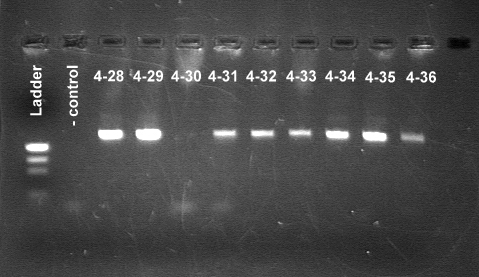Katrina Underhill and Nicholas Cherney performed PCR amplification on the extracted DNA from nine orchid species. The DNA was previously extracted by fellow students and Dr. Jarrell. The objective of this procedure was to amplify the petB intron in DNA samples 4-10 through 4-18.

The results showed that five of our nine specimens had a good yield. Two of our specimens had a mildly successful yield, Thrixspermum bromeliforme (4-13) and Renanthera storei (4-15). Cleisostoma subulatum (4-10) and Holcoglossum flavescens (4-14) failed to produce product entirely. After comparing our results with the molecular mass ruler provided by Dr. Jarrell, the majority of our samples appear to be around 1000 bp while our two lower yields appear to be around 500 bp.
Table 1: PCR Results
|
Lane |
DNA Code |
Species Name |
PCR Yield |
|
1 |
– |
Gel marker | |
|
2 |
– |
Control | |
|
3 |
4-10 |
Cleisostoma subulatum |
– |
|
4 |
4-11 |
Chroniochilus virescens |
++ |
|
5 |
4-12 |
Ceratocentron fesselii |
++ |
|
6 |
4-13 |
Thrixspermum bromeliforme |
+ |
|
7 |
4-14 |
Holcoglossum flavescens |
– |
|
8 |
4-15 |
Renanthera storei |
+ |
|
9 |
4-16 |
Trichoglottis amesiana |
++ |
|
10 |
4-17 |
Omoea philippinensis |
++ |
|
11 |
4-18 |
Gastrochilus acutifolius |
++ |





You must be logged in to post a comment.